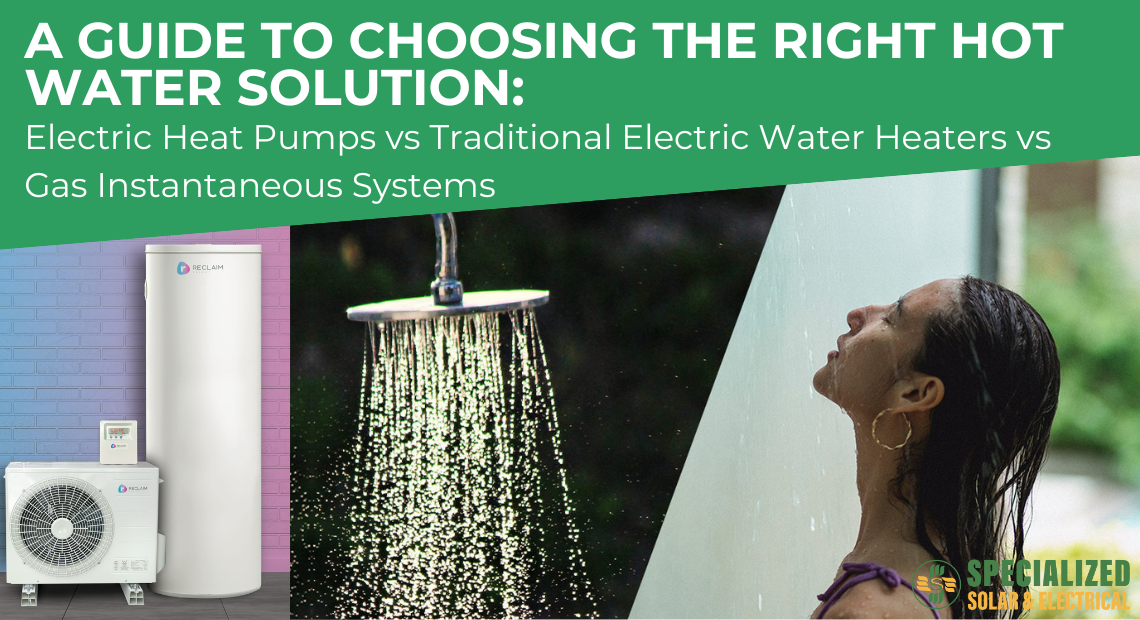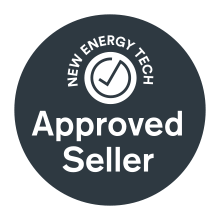Electric heat pumps, traditional electric element tanks, and gas instantaneous water systems each have unique methods of heating water. Here’s a detailed explanation of how each system works and the differences between them:
Electric Hot Water Heat Pump
How It Works:
- Heat Absorption: An electric heat pump water heater transfers heat from the surrounding air into the water. It works similarly to a refrigerator but in reverse.
- Components: It uses a compressor, a condenser coil, an evaporator coil, and a refrigerant to move heat.
- Process:
- Evaporation: The refrigerant absorbs heat from the air and evaporates into a gas.
- Compression: The gas is then compressed, raising its temperature further.
- Condensation: The hot gas passes through the condenser coil, transferring its heat to the water and condensing back into a liquid.
- Expansion: The refrigerant then goes through an expansion valve to lower its pressure and temperature before returning to the evaporator coil to repeat the cycle.
Please use image from here: https://www.energystar.gov/products/heat_pump_water_heaters/how-it-works
Advantages:
- Energy Efficiency: Heat pumps are much more efficient than traditional electric water heaters because they move heat instead of generating it, using 60%–70% less electricity.
- Lower Operating Costs: Due to their high efficiency, they can significantly reduce electricity bills.
- Environmentally Friendly: They emit fewer greenhouse gases compared to gas systems.
Traditional Electric Element Tank
How It Works:
- Heating Elements: This system uses electrical resistance elements (usually two) immersed in the water tank to heat the water directly.
- Thermostat Control: The heating elements are controlled by thermostats that maintain the water at a set temperature.
- Insulated Tank: The tank is insulated to keep the water warm until it is needed.
Advantages:
- Simplicity: Electric tank heaters are straightforward and have been in use for many years.
- Installation Cost: They typically have a lower upfront cost compared to heat pumps.
Disadvantages:
- Energy Consumption: They are less efficient because they convert electricity directly into heat.
- Standby Heat Loss: The tank continuously loses heat, which can lead to higher energy usage to keep the water hot.
Gas Instantaneous (Tankless) Water System
How It Works:
- On-Demand Heating: The system heats water on demand as it flows through the unit, using a gas burner.
- No Storage Tank: Since there is no storage tank, water is heated only when needed, eliminating standby losses.
- Flow Sensor: When a hot water tap is opened, a flow sensor activates the gas burner to heat the water.
Advantages:
- Efficiency: More efficient than traditional storage tanks because they only heat water when required.
- Endless Hot Water: Can provide a continuous supply of hot water as long as there is demand.
Disadvantages:
- Gas Supply: Requires a natural gas or propane supply.
- Installation Cost: Typically, more expensive to install, especially if retrofitting a house not already set up for gas.
- Maintenance: May require more maintenance due to complex components.
Key Differences:
| Feature | Electric Heat Pump | Electric Element Tank | Gas Instantaneous |
| Energy Source | Electricity (via heat transfer) | Electricity (via resistance elements) | Natural gas or propane |
| Heating Method | Transfers heat from air | Heats water directly | Heats water on demand |
| Efficiency | Very high | Moderate | High |
| Operating Cost | Lower | Higher | Moderate to lower |
| Hot Water Supply | Limited by tank size | Limited by tank size | Endless when demand is met |
| Installation Cost | Higher | Lower | Higher |
| Environmental Impact | Low emissions | Moderate emissions | Moderate emissions |
In summary, electric heat pumps are highly efficient and environmentally friendly, making them an attractive option for reducing energy costs and emissions. Traditional electric element tanks are simpler but less efficient, while gas instantaneous systems offer on-demand hot water but require a gas supply.












